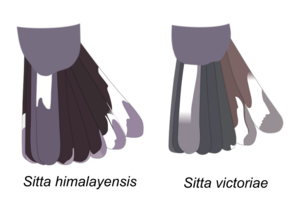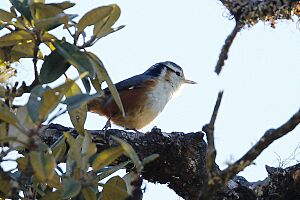White-browed nuthatch facts for kids
Quick facts for kids White-browed nuthatch |
|
|---|---|
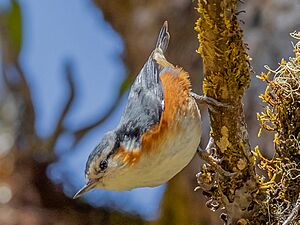 |
|
| Conservation status | |
| Scientific classification | |
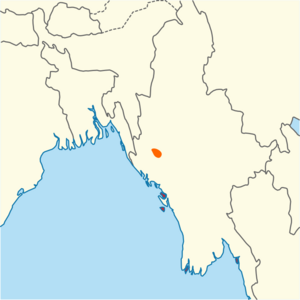 |
|
| White-browed nuthatch range | |
| Synonyms | |
|
The white-browed nuthatch (Sitta victoriae), also called the Victoria nuthatch, is a type of bird in the Sittidae family. It's a small bird, about 11.5 cm (4.5 in) long. Male and female nuthatches look very similar.
Like many other nuthatches, this bird has gray-blue feathers on its back and wings. Its throat, cheeks, and chest are white. The sides of its body, belly, and lower tummy are orange. A white stripe above its eye, called a supercilium, helps tell it apart from the white-tailed nuthatch.
This nuthatch lives only in Myanmar. It is found in old oak forests high up in the mountains. Scientists don't know much about its life, but it eats small insects it finds on tree bark and lichens. It usually lays eggs around April.
The white-browed nuthatch is an endemic species, meaning it lives only in one specific area. Its home is Nat Ma Taung, also known as Mount Victoria, in the southern Chin Hills of Myanmar. This bird lives in old oak forests high up, usually above 2,600 m (8,500 ft).
There are only a few thousand of these birds left. Their homes are being destroyed by fires and human activities. Because of this, the International Union for the Conservation of Nature (IUCN) lists the white-browed nuthatch as an "endangered species."
Contents
About the White-browed Nuthatch
The white-browed nuthatch was first described in 1904. A British bird expert named George Rippon gave it its scientific name, Sitta victoriae. He named it after Mount Victoria, where he found many birds.
Scientists think this nuthatch is closely related to the white-tailed nuthatch (S. himalayensis). Some experts even thought it was a subspecies of the white-tailed nuthatch. However, there are differences between them, like the white stripe above its eye.
The white-browed nuthatch is part of a larger group of nuthatches. Scientists study their family tree to understand how they are related.
| Nuthatch family tree according to Packert, et al. (2020): | ||||||||||||||||||||||||||||||||||||||||||
|---|---|---|---|---|---|---|---|---|---|---|---|---|---|---|---|---|---|---|---|---|---|---|---|---|---|---|---|---|---|---|---|---|---|---|---|---|---|---|---|---|---|---|
|
What the White-browed Nuthatch Looks Like
The white-browed nuthatch is a small bird, about 11.5 cm (4.5 in) long. Its wings are about 68–73 mm (2.7–2.9 in) long for males and 67–69 mm (2.6–2.7 in) for females. Its tail is about 36–37 mm (1.4–1.5 in) long. The beak is about 15–16 mm (0.59–0.63 in) long.
The top part of the nuthatch's body is dull bluish-gray. Its throat and lower chest are white. The belly is orange, and the underside of its tail is light red. The sides of its body are darker orange.
This nuthatch has a white forehead and white "eyebrows" (supercilium). There's a black line behind its eye that gets thicker towards the back of its neck. Its cheeks are white like its throat, but the back of the cheek is orange.
Young nuthatches look similar but have lighter orange-red sides. The beak is black at the tip and gray otherwise. Its legs are dull yellowish-brown.
How to Tell it Apart from Other Birds
The white-browed nuthatch can sometimes be confused with the white-tailed nuthatch. However, the white-browed nuthatch has a clear white stripe above its eye. Its central tail feathers are light gray at the tip and mostly white at the base.
It also has a narrow black stripe through its eye that gets wider on its upper back. The strong contrast between its white chest and dark red sides is another clue. Plus, its beak is shorter and thinner than the white-tailed nuthatch's.
Life and Habits
Nuthatches are usually seen alone or in pairs. They are busy birds, always looking for food.
What They Sound Like
The white-browed nuthatch makes a simple "pit" or "plit" sound. It also has a faster call, like "pii, pii, pii..." which it repeats quickly. Sometimes, it sings a soft, slow trill that sounds like "tuwi-tuwi-tuwi."
What They Eat
This nuthatch mainly eats small insects. It finds them in plants called epiphytes that grow on oak trees. It also looks for insects in hollows in the tree bark.
They search for food on the outer branches of trees. They also look on inner branches and the main tree trunk. They often look for food on oak trees, but also on rhododendron and pine trees.
Reproduction and Nests
Scientists don't know much about how these birds reproduce. In 2003, a bird expert saw three nests between March and April. Two nests were inside hollows in oak tree branches, about 4 m (160 in) and 10 m (390 in) high. The third nest was in a rhododendron tree trunk, six meters high.
The female nuthatch digs the nest hole by herself. Unlike some other nuthatches, she doesn't seem to block up the entrance with mud. It looks like only the female feeds the young birds. In April, three groups of young birds were seen, each with two grown-up young.
Where They Live
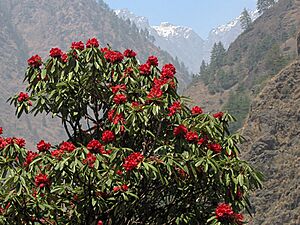
The white-browed nuthatch lives only in western Myanmar. You can find it in the southern Chin Hills, especially around Nat Ma Taung (Mount Victoria). It has also been seen near Mindat.
These birds prefer old oak forests covered with lichens and other plants. They avoid pure pine forests. They are usually found at high altitudes, above 2,600 m (8,500 ft). However, they might move to slightly lower areas during winter.
Their home is mainly in Quercus semecarpifolia oak trees. These trees are often covered with epiphytic plants, lichens, mosses, orchids, and ferns.
Why They Need Our Help
The white-browed nuthatch is one of only four bird species that live only in Myanmar. Scientists have counted them, but their numbers are small. In 1995, 14 birds were seen. In 2000, only five were seen over two weeks. Later, 45 birds were seen over four months.
Surveys in 2007 didn't find any of these nuthatches in other parts of the Chin Hills. This suggests they live only in the Nat Ma Taung area. Experts believe there are only about 2,500 to 10,000 adult birds left.
The forests where they live are being destroyed. Near Nat Ma Taung, forests have been cleared up to 2,000 m (6,600 ft). The remaining forests are badly damaged. Many people live in Natmataung National Park, and their activities, like trapping and starting fires, harm the birds.
The number of white-browed nuthatches is going down. Myanmar has a law to protect wildlife, but it's not always followed. This means the birds' homes are still being destroyed. Because of these threats, the International Union for the Conservation of Nature (IUCN) calls the white-browed nuthatch an "endangered species." This means it is at high risk of disappearing forever.



